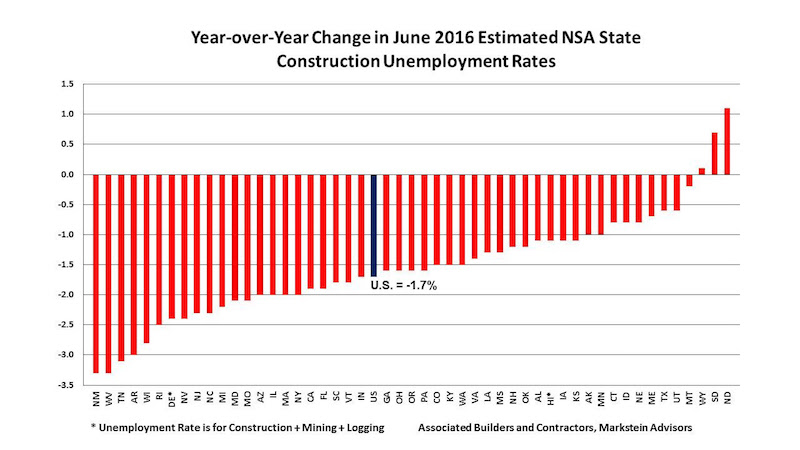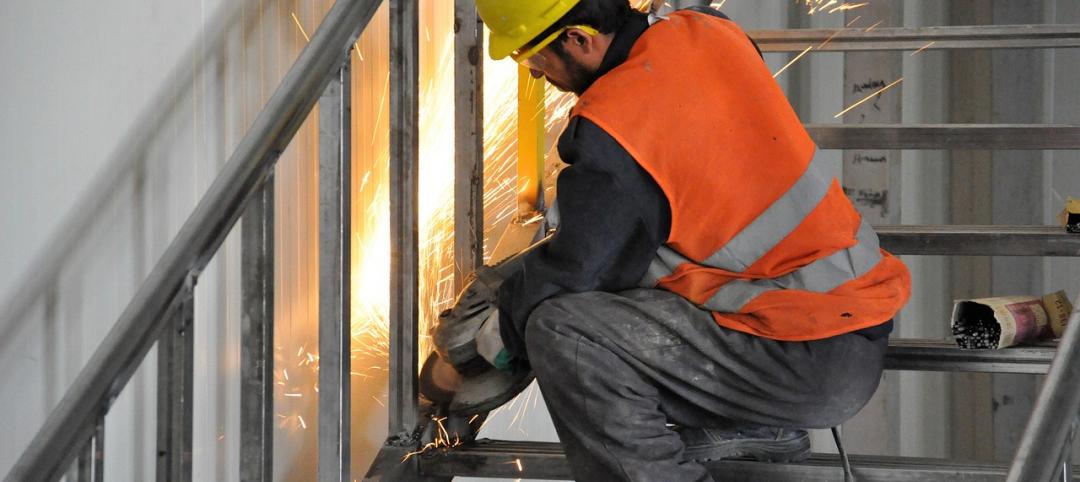June not seasonally adjusted (NSA) construction unemployment rates improved in 47 states and the nation on a year-over-year basis according to analysis released today by Associated Builders and Contractors (ABC). The national construction unemployment rate of 4.6 percent was 1.7 percent lower than a year ago according to data from the Bureau of Labor Statistics (BLS). Further, the industry boasted its lowest June rate since 2000 when it matched this June’s 4.6 percent rate. BLS data also showed that the industry employed 229,000 more people than in June 2015.
“Starting in 2000, when the BLS data for this series begins, the June national NSA construction unemployment rate has fallen from May every year except 2010 when it was unchanged. This is not surprising given that this is not seasonally adjusted data and that construction activity normally continues to rise nationwide as the weather improves throughout the country. This year’s decrease of 0.6 percent from May continues this pattern,” says economist Bernard M. Markstein, Ph.D., President and Chief Economist of Markstein Advisors, who conducted the analysis for ABC.
The five states with the lowest estimated NSA construction unemployment rates in order from lowest rate to highest were:
1. Vermont
2. Colorado
3. Idaho and Iowa (tie)
5. Nebraska
Three states—Iowa, Nebraska and Vermont—were also among the top five in May.
The five states with the highest estimated NSA construction unemployment rates (from lowest to highest) were:
46. Mississippi
47. Connecticut
48. Rhode Island
49. New Mexico
50. Alabama
Alabama, New Mexico and Rhode Island were also in the bottom five in May.
View states ranked by their construction unemployment rate, their year-over-year improvement in construction employment and monthly improvement in construction employment.


Read more on ABC's website.
Related Stories
Market Data | Feb 24, 2021
2021 won’t be a growth year for construction spending, says latest JLL forecast
Predicts second-half improvement toward normalization next year.
Healthcare Facilities | Feb 18, 2021
The Weekly show, Feb 18, 2021: What patients want from healthcare facilities, and Post-COVID retail trends
This week on The Weekly show, BD+C editors speak with AEC industry leaders from JLL and Landini Associates about what patients want from healthcare facilities, based on JLL's recent survey of 4,015 patients, and making online sales work for a retail sector recovery.
Market Data | Jan 19, 2021
2021 construction forecast: Nonresidential building spending will drop 5.7%, bounce back in 2022
Healthcare and public safety are the only nonresidential construction sectors that will see growth in spending in 2021, according to AIA's 2021 Consensus Construction Forecast.
AEC Tech | Feb 13, 2020
Exclusive research: Download the final report for BD+C's Giants 300 Technology and Innovation Study
This survey of 130 of the nation's largest architecture, engineering, and construction firms tracks the state of AEC technology adoption and innovation initiatives at the AEC Giants.
Office Buildings | Feb 11, 2020
Forget Class A: The opportunity is with Class B and C office properties
There’s money to be made in rehabbing Class B and Class C office buildings, according to a new ULI report.
Industry Research | Dec 13, 2019
Attention building design experts: BD+C editors need your input for our 2020 Color Trends Survey
The 2020 Color Trends research project will assess leading and emerging trends and drivers related to the use of color on commercial, institutional, and multifamily building projects.
Architects | Sep 11, 2019
Buoyed by construction activity, architect compensation continues to see healthy gains
The latest AIA report breaks down its survey data by 44 positions and 28 metros.
Industry Research | Aug 29, 2019
Construction firms expect labor shortages to worsen over the next year
A new AGC-Autodesk survey finds more companies turning to technology to support their jobsites.
Codes and Standards | Aug 29, 2019
Industry leaders ask for government help as trades shortage worsens
AGC asks for more funding for education and increased immigration to fill gaps.

















